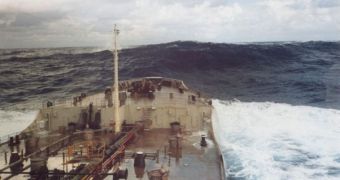The new case of a cruise ship getting battered by a large wave that came out of the blue again drew attention on rogue waves, a phenomenon that is fairly rare, but can have disastrous consequences. Although experts have agreed that the recent incident – which involved a cruise ship navigating through the Mediterranean Sea getting hit by a large body of water – was not caused by a rogue wave, they add that other types of unexpected manifestations can be encountered in the world's oceans. In the new case, the water wall hit the bow section of the ship, breaking plate-glass, hurting one person, and killing an additional two, Wired reports.
Scientists say that although the event was not the result of a rogue wave, the water motions that led to the catastrophe may have been caused by the same underlying principles. The recent wave had a height of just 26 feet (some 8 meters), which is considered relatively harmless on the sea. Oceanographers state that a freak wave meets the officially established definition of a rogue when its height is twice that of the “significant wave height.” This concept refers to the average height of all tallest third waves in the vicinity of a ship. University of California in Santa Barbara (UCSB) oceanographer Libe Washburn said that the recent wave was not by far the largest he ever saw.
“I was surprised it was really that damaged by a 26-foot-high wave. Twenty-six feet isn’t that big,” he revealed. Analyzing and figuring out rogue waves is very difficult, mostly because, for a long time, scientists didn't even believe they existed. They were shown to be happening only a few years back, through studies conducted by the European Commission-funded MaxWave research group. Data collected from satellites was also used to confirm their existence. The experts were able to conclude that the main formation mechanism is when two smaller waves come together.
“You get waves that add up – smaller waves that constructively interfere and for a short time produce a very large wave. When they add up, they can make an extra high crest and an extra deep trough,” Washburn explained. He added that winds blowing strongly also contribute to this effect. Their air masses transfer some of their energy to the waves, causing even more interactions between them, and thus promoting the possibility of the coalescing and forming rogue waves.

 14 DAY TRIAL //
14 DAY TRIAL //